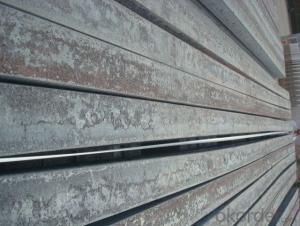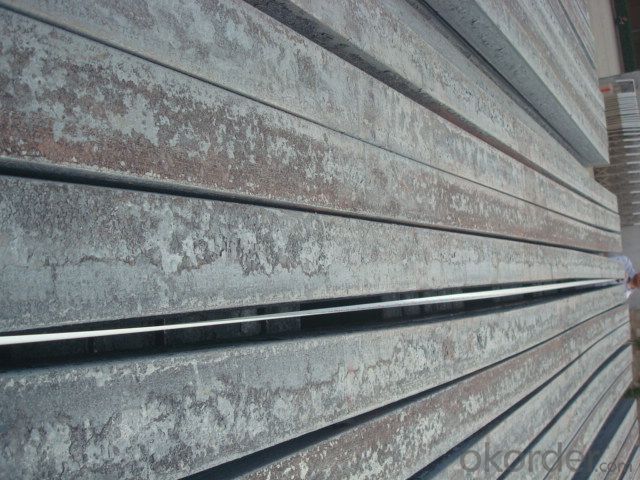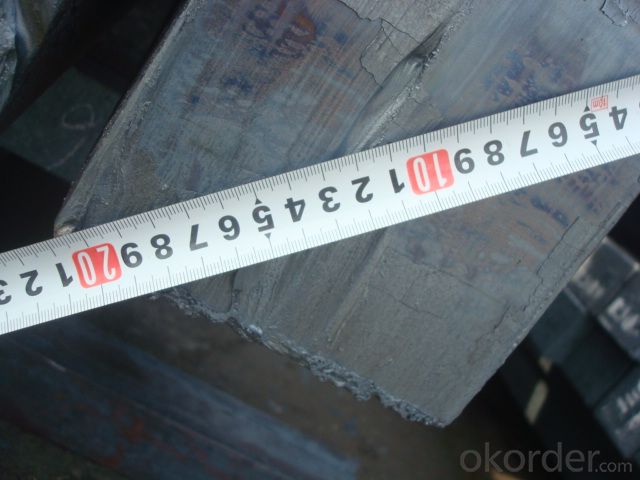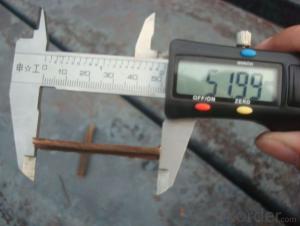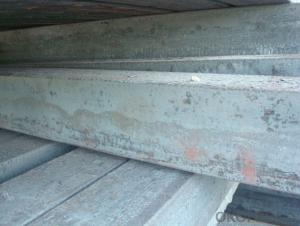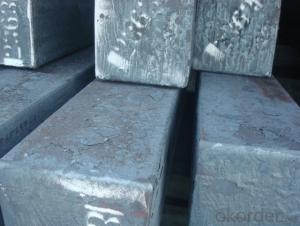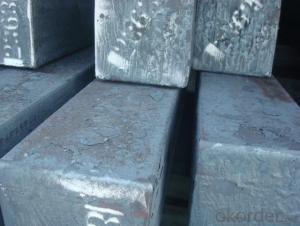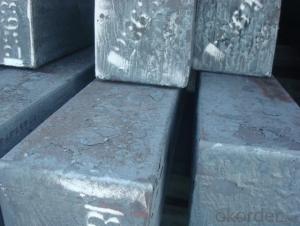Alloyed Continue Casting Steel Billet by Blast Furnace
- Loading Port:
- Tianjin
- Payment Terms:
- TT OR LC
- Min Order Qty:
- 1000 m.t.
- Supply Capability:
- 10000 m.t./month
OKorder Service Pledge
OKorder Financial Service
You Might Also Like
Alloyed Continue Casting Steel Billet by Blast Furnace
1.Structure of Alloyed Continue Casting Steel Billet by Blast Furnace
Steel Blooms Manufactured by Continue Casting is the raw material of all kinds of steel mill. Bloom section of square, round, flat, rectangular and abnormity, etc Several, mainly related to shape of rolled products. Simple rolled section steel, choose cross section of square Bloom or rectangular Bloom. rolling The sector products such as flat steel, Angle steel, select the rectangular Bloom or slab. Had better profiled Bloom when production beams, channels, and in rolling process Lines and improve the yield. The raw material of round Bloom is the production of seamless tube.
2.Main Features of Alloyed Continue Casting Steel Billet by Blast Furnace.
Steel Blooms Manufactured by Continue Casting section size should meet the requirements of rolling deformation and finished product quality, but also roll strength and biting condition of restrictions. General steel Bloom section height H. And the roll diameter D The ratio of the ( namely H/D) Should be less than or equal to zero 0.5 . Length of steel Bloom by finishing temperature, Rolling time and the length of the product Or times ruler. When heated too long accident prone to bump the furnace wall of steel, too short, furnace bottom utilization rate is not high, influence the heating furnace production. For the production Choose a variety of steel and steel Bloom, should consider the affinities of Bloom, as far as possible in order to improve the productivity of the roughing mill, simplify the stock management of workshop.
There are three shapes of the steel Blooms: square Bloom, slab, rectangular Bloom The Chinese Bloom, rectangular Bloom is mainly suitable for rolling hot rolled strip, building reinforced bar, Ordinary wire, high speed wire rod and various small profile. Of the slab are mainly used for rolling plate and hot coil sheet.
3. Alloyed Continue Casting Steel Billet by Blast Furnace Images
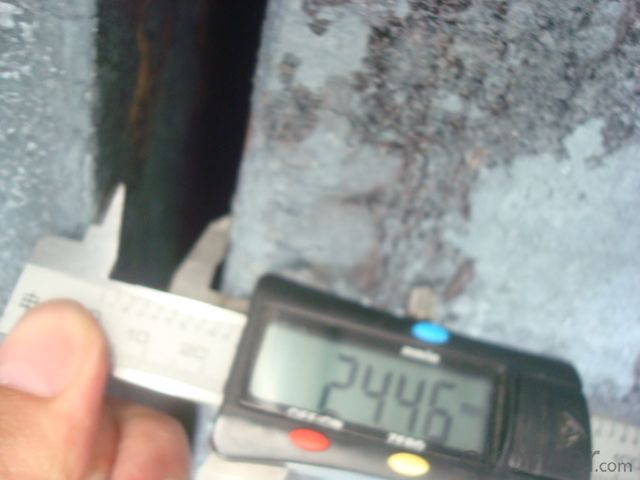
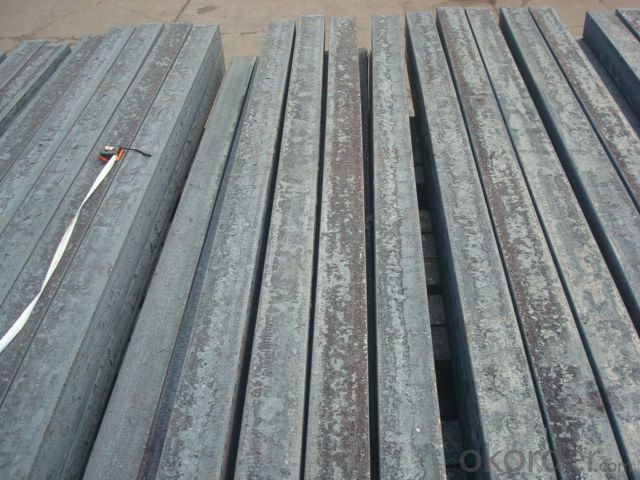
4. Alloyed Continue Casting Steel Billet by Blast Furnace Specification
Alloyed Continue Casting Steel Billet by Blast Furnace rolled steel, after processing can be used for mechanical parts, forging parts, processing all kinds of steel, steel Q345B channel steel, wire rod is the role of the Bloom. Steel Bloom is used in the production of semi-finished products, generally cannot be used directly for the society. Steel Blooms and steel are strictly divided into standard, cannot decide to whether the business enterprise of the final product, and according to unified standards to perform the whole society. Typically, Bloom and the steel is relatively easy to distinguish, but for some steel Bloom, and have the same specification and same steel purposes (such as rolling tube Bloom), whether can be used for other industries, whether through steel processing process, whether through a finished product rolling mill processing to distinguish
Material standard The editor Range of thickness: 150-240 - mm + / - 5 mm width range: 880-1530 - mm + / - 20 mm Length: 3700-10000 - mm + / - 500 - mm Cross-sectional size: 64 * 64; 82 * 82; 98 * 98; 124 * 124; 120 * 150; 152 * 164; 152 * 170 mm Length: 9000 mm Section of tolerance: Bloom: 1.0 + / - 2.0-1.0 + / - 1.0 mm slab: width: + / - 2.0 mm thickness: + / - 3.0 mm The length tolerance: + / - 200 mm Section diagonal tolerance: 3.5-8.0 MM Bloom section size protrusions requirements: < 1242 mm, do not allow; > = 1242 mm, < = 2 mm 1242 mm, < = 3 mm Beheading (shear) extension deformation: < 1242 mm Bloom: no control; The slab: < = 15 mm Surface tilt: no more than Bloom section 0.1 Bending: every 1 m length is not more than 10 mm The distortion: length < = 5 m, < = 11. ; The length of the < = 7.5 M, < = 5. Material % 3 sp/PS chemical composition: C Mn Si S P
5.FAQ of Alloyed Continue Casting Steel Billet by Blast Furnace
We have organized several common questions for our clients,may help you sincerely:
①How about your company?
A world class manufacturer & supplier of castings forging in carbon steel and alloy steel,is one of the large-scale professional investment casting production bases in China,consisting of both casting foundry forging and machining factory. Annually more than 8000 tons Precision casting and forging parts are exported to markets in Europe,America and Japan. OEM casting and forging service available according to customer’s requirements.
②How to guarantee the quality of the products?
We have established the international advanced quality management system,every link from raw material to final product we have strict quality test;We resolutely put an end to unqualified products flowing into the market. At the same time, we will provide necessary follow-up service assurance.
③Could arrange the inspection before shipping?
Yes, you can. And you can arrange like the SGS, INTERTECH third party inspecting company to check for you before shipping.
- Q: What are the main factors affecting the corrosion resistance of carbon steel billets?
- Several primary factors influence the corrosion resistance of carbon steel billets. 1. Composition: The composition of carbon steel billets plays a vital role in determining their resistance to corrosion. Certain alloying elements, such as chromium, nickel, and copper, can enhance their corrosion resistance by forming a protective layer on the steel surface and preventing the formation of rust or other corrosive products. 2. Environmental conditions: The corrosion resistance of carbon steel billets is also influenced by the environment in which they are exposed. Factors like humidity, temperature, pH level, and the presence of corrosive substances like acids or salts can accelerate the corrosion process. For example, high humidity and acidic conditions can increase the rate of corrosion. 3. Surface condition: The condition of the carbon steel billet's surface is crucial for its corrosion resistance. Any imperfections, scratches, or roughness on the surface can serve as initiation sites for corrosion. To minimize the chances of corrosion, it is essential to maintain a smooth and clean surface. 4. Protective coatings: The application of protective coatings, such as paints, varnishes, or corrosion inhibitors, can significantly enhance the corrosion resistance of carbon steel billets. These coatings act as a barrier between the steel surface and the corrosive environment, thereby reducing direct contact and slowing down the corrosion rate. 5. Galvanic corrosion: Carbon steel billets can experience galvanic corrosion when they come into contact with dissimilar metals or alloys in the presence of an electrolyte. The difference in electrical potential between the metals creates a galvanic cell, leading to accelerated corrosion of the less noble metal (carbon steel). Proper insulation or the use of sacrificial anodes can help mitigate galvanic corrosion. In conclusion, the corrosion resistance of carbon steel billets is influenced by factors such as composition, environmental conditions, surface condition, protective coatings, and the possibility of galvanic corrosion. By taking these factors into account and implementing appropriate measures, the corrosion resistance of carbon steel billets can be effectively improved.
- Q: What shape is the billet?
- Steel billet is a product made by steel-making furnace by casting. The billet can be divided into two kinds from the manufacturing process, mould blank and continuous casting billet. At present, the casting process has been basically eliminated.classification
- Q: How are steel billets inspected for quality control?
- Steel billets are inspected for quality control through a series of rigorous tests and inspections. The process starts with visual inspection, where the billets are examined for any visible defects or irregularities in shape, size, surface finish, or any signs of cracks or inclusions. After the visual inspection, the billets undergo various non-destructive testing techniques such as ultrasonic testing (UT) and magnetic particle inspection (MPI). UT uses high-frequency sound waves to detect any internal flaws or defects in the billets, while MPI uses magnetic fields and iron particles to identify surface cracks or discontinuities. In addition to non-destructive testing, destructive tests are also conducted to assess the mechanical properties of the billets. These tests include tensile testing, where a sample is subjected to tension until it breaks to measure its strength and elongation properties. Hardness testing is performed using various methods like Rockwell or Brinell tests to determine the billet's resistance to indentation or deformation. Chemical analysis is another critical aspect of quality control. Samples are taken from the billets and subjected to spectroscopic analysis to determine the chemical composition, ensuring that it meets the required specifications and standards. Furthermore, dimensional measurements are carried out to verify the billets' accuracy in terms of length, diameter, and other dimensional tolerances. This is done using precision measuring tools such as micrometers and calipers. Overall, a combination of visual inspection, non-destructive testing, destructive testing, chemical analysis, and dimensional measurements is employed to ensure the quality of steel billets. These comprehensive quality control measures help identify any defects or inconsistencies, guaranteeing that the billets meet the required standards and are suitable for further processing in the steel industry.
- Q: Can steel billets be heat treated for increased hardness?
- Yes, steel billets can be heat treated to increase hardness. Heat treatment processes such as quenching and tempering can be used to alter the microstructure of the steel, resulting in improved hardness and other mechanical properties.
- Q: How do steel billets contribute to energy efficiency?
- Steel billets contribute to energy efficiency in several ways. Firstly, the production of steel billets typically involves recycling scrap metal, which requires significantly less energy compared to producing steel from raw materials. This recycling process helps conserve energy and reduces the carbon footprint associated with steel production. Additionally, steel billets are often used as a raw material in various industries, such as construction and manufacturing. The durability and strength of steel make it a long-lasting and energy-efficient material for building structures and producing goods. Its high thermal conductivity also allows for efficient heat transfer, making it suitable for applications that require temperature control or energy conservation. Overall, steel billets play a vital role in promoting energy efficiency by minimizing energy consumption during production and offering sustainable solutions in various sectors.
- Q: How are steel billets used in the production of railway infrastructure?
- The production of railway infrastructure relies heavily on steel billets, which are crucial for creating various railway components such as rails, sleepers, and fasteners. These semi-finished steel products undergo a hot rolling process to shape them into long and narrow sections with consistent cross-sections, serving as the foundation for railway tracks. Rails, one of the primary uses of steel billets in railway infrastructure, are formed from the processed billets. These rails, available in different lengths and dimensions, provide stability and a sturdy platform for trains to run on. The strength and durability of steel ensure that the tracks can withstand heavy loads and frequent traffic. Steel billets are also used to manufacture sleepers, which act as horizontal supports for the rails. Concrete or wooden sleepers are created from the shaped and formed billets and are laid on the track bed to maintain the alignment and gauge of the tracks. Sleepers play a vital role in distributing the weight of trains and providing stability. Furthermore, steel billets are essential in producing fasteners like bolts, nuts, and clips. These fasteners secure the rails to the sleepers, ensuring that they remain in position during train operations. Steel's strength and resilience make it a reliable material for these critical components, which must withstand significant stress and vibrations. In conclusion, steel billets are indispensable in the production of railway infrastructure. Their versatility and strength make them suitable for creating rails, sleepers, and fasteners, which are vital for a reliable and robust railway system. Without steel billets, the construction and maintenance of railway tracks would be impossible, impacting the efficiency and safety of train operations.
- Q: How do steel billets contribute to the circular economy?
- Steel billets contribute to the circular economy in several ways. Firstly, they are a key component in the recycling process of steel. Steel is one of the most recycled materials in the world, and the use of steel billets enables the recycling of scrap steel into new products. By using steel billets, the steel industry can reduce the demand for virgin iron ore and the energy-intensive processes associated with its extraction and production. Moreover, steel billets can be produced from various sources, including industrial waste, automotive scrap, and construction waste. This allows for the repurposing of materials that would otherwise end up in landfills, reducing waste and conserving resources. By utilizing steel billets made from recycled materials, the industry can promote a more sustainable and environmentally friendly approach to steel production. Furthermore, steel billets are highly versatile and can be used in a wide range of applications. This versatility extends the lifespan of steel products and reduces the need for replacement. In the circular economy, the aim is to maximize the use of resources, and steel billets contribute to this goal by enabling the production of durable and long-lasting steel products. Lastly, the circular economy emphasizes the importance of closing the loop and ensuring that materials are reused or recycled at the end of their life cycle. Steel billets facilitate this process by being a readily available feedstock for the production of new steel products. This not only reduces the reliance on virgin materials but also minimizes the environmental impact associated with extracting and processing raw materials. In conclusion, steel billets play a crucial role in the circular economy by enabling the recycling of steel, repurposing of waste materials, promoting durability, and closing the loop in the steel production process. Their use contributes to the conservation of resources, reduction of waste, and overall sustainability of the steel industry.
- Q: How do steel billets contribute to the transportation industry?
- Steel billets are a vital component in the transportation industry as they are used to manufacture various parts and components for vehicles. These billets are transformed into products like engine blocks, chassis frames, axles, and suspension systems, which provide strength, durability, and stability to vehicles. Additionally, steel billets are also used to produce railway tracks and infrastructure, ensuring safe and efficient transportation of goods and people. Overall, steel billets play a crucial role in enhancing the performance, safety, and reliability of transportation systems.
- Q: How are steel billets used in the manufacturing of electrical transmission equipment?
- Steel billets serve as a key raw material in the manufacturing of electrical transmission equipment. They are solid blocks of steel that undergo further processing to create various components necessary for electrical transmission equipment. One crucial application of steel billets in this field is for the production of transmission towers. These towers are essential infrastructure that supports power lines and facilitates the secure and efficient transmission of electricity over long distances. Steel billets are utilized in the manufacturing of the structural elements of these towers, including the main vertical and horizontal members, as well as the cross arms and braces. Moreover, steel billets are also employed in the production of conductors for electrical transmission equipment. Conductors are the cables responsible for carrying electrical current between power generation stations and distribution networks. Steel billets are processed to create the wires and strands required to construct these conductors. The remarkable strength and durability of steel make it an excellent material choice for these applications, as it can withstand the high tension and load demands of electrical transmission systems. Furthermore, steel billets are utilized in the manufacturing of various other components used in electrical transmission equipment, such as pole line hardware, insulators, and connectors. These components are essential for the proper functioning and reliability of the electrical transmission system, and steel billets provide the necessary strength and stability required for their construction. To summarize, steel billets play a crucial role in the manufacturing of electrical transmission equipment. They are used to produce transmission towers, conductors, and other vital components, ensuring the safe and efficient transmission of electricity over long distances.
- Q: What are the potential applications of steel billets in the defense sector?
- Due to their strength, durability, and versatility, steel billets have numerous potential applications in the defense sector. Here are several examples: 1. Armored Vehicles: Steel billets can be utilized to manufacture the hulls and components of armored vehicles, offering improved protection against ballistic threats and explosive devices. Their high strength and toughness make them suitable for enduring extreme conditions and impacts on the battlefield. 2. Weapon Systems: Steel billets can be incorporated into the production of various weapon systems, such as artillery guns, tanks, and missile launchers. These components require materials capable of withstanding high pressures, heat, and mechanical stresses, all of which steel billets can provide. 3. Defense Infrastructure: Steel billets can be employed in the construction of defense infrastructure, including military bases, bunkers, and fortifications. Their high strength and resistance to corrosion make them suitable for enduring environmental and physical challenges. 4. Naval Applications: Steel billets are crucial in the manufacturing of naval vessels, such as submarines, destroyers, and aircraft carriers. The ability of steel billets to withstand the harsh conditions of the marine environment, including corrosion and pressure, makes them an ideal choice for constructing these vessels. 5. Personal Protective Equipment (PPE): Steel billets can be used to produce body armor, helmets, and other protective gear for military personnel. The exceptional strength and impact resistance of steel billets offer enhanced protection against bullets, shrapnel, and other potential threats on the battlefield. 6. Military Infrastructure: Steel billets can be utilized in the construction of bridges, runways, and other critical military infrastructure. Their high load-bearing capacity and durability ensure the longevity and reliability of these structures, thereby supporting military operations. Overall, steel billets have diverse and crucial potential applications in the defense sector. Their properties make them an invaluable material for various defense applications, ensuring the protection of personnel, equipment, and infrastructure in challenging operational environments.
Send your message to us
Alloyed Continue Casting Steel Billet by Blast Furnace
- Loading Port:
- Tianjin
- Payment Terms:
- TT OR LC
- Min Order Qty:
- 1000 m.t.
- Supply Capability:
- 10000 m.t./month
OKorder Service Pledge
OKorder Financial Service
Similar products
Hot products
Hot Searches
Related keywords
